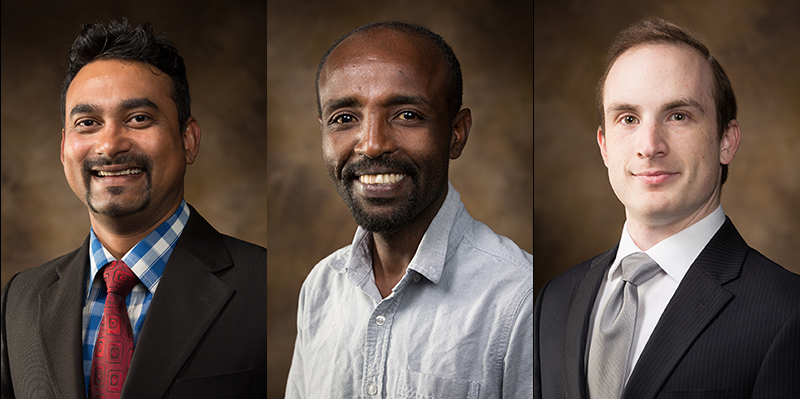Research Reveals Insights Into Optical Properties of Plasmonic Nanostructures

From left: Pijush K. Ghosh, Desalegn T. Debu and David A. French.
FAYETTEVILLE, Ark. – University of Arkansas researchers have helped define the optical properties of plasmonic nanostructures, work that could lead to improved sensors in security and biomedical devices, and have applications in solar cells. The research team in the Department of Physics recently published its findings in the journal PLOS ONE.
Plasmons are waves of electrons on the surface of a metal. The frequency of these electronic waves can be altered to couple with light by changing the particle size, shape, material and surrounding environment. The plasmons can increase light intensity and focus the light down to nanoscale volumes, which can be useful for a variety of nanoscience applications.
The core of the work is the subject of graduate student Pijush K. Ghosh’s master thesis in physics. Ghosh collaborated with fellow graduate students Desalegn T. Debu and David A. French for the journal article, titled “Calculated thickness dependent plasmonic properties of gold nanobars in the visible to near-infrared light regime.” The students are part of a physics research group led by assistant professor Joseph Herzog.
This work explores the optical properties of rectangular-shaped gold nanoparticles, in particular how they scatter light and the strength of the scattered light near the nanoparticle. The researchers determined how variations in the structures’ geometry affected how they coupled with light, making it easier to work with structures that aren’t perfectly square. The findings could enable plasmonic devices, such as sensors, to be more accurately tuned for a specific application.
“Making nanostructures with perfectly square corners is difficult using common nanofabrication techniques,” Ghosh said. “In our work, we investigated realistic structures with rounded corners. The work determined the difference in resonance wavelength of round-corner and sharp-corner nanobars. We also found how the spectrum precisely shifts as you make thicker nanobars. This reveals insight into another dimension of the structures that allows for more control and tunability of these plasmonic nanostructures.”
Ghosh is pursuing his doctorate in electrical engineering. He is working on a thin-film capacitor project with funding from the U of A’s Center for Power Optimization of Electro-Thermal System, a National Science Foundation-sponsored center.
Contacts
Joseph Herzog, assistant professor
Department of Physics
479-575-4217,
jbherzog@uark.edu
Bob Whitby, feature writer
University Relations
479-575-4737,
whitby@uark.edu
Headlines
U of A Bands to Hold Three Nights of Concerts
The Symphonic Band, the Wind Symphony, the 4 O'Clock and 5 O'Clock Bands and the Wind Ensemble will perform April 21-23 at the Faulkner Performing Arts Center on the U of A campus.
Honors College to Host 'Best in Show' Dog Celebration
The campus and community are invited to celebrate our furry friends with popsicles, water and dog treats from 3-4 p.m. Thursday, April 25, in the Gearhart Courtyard.
New Parasite Affecting Canadian Partridges Named for Arkansas Poultry Scientist
A long-time colleague in Canada gave a newly found parasite the scientific name Eimeria hargisi in honor of U of A poultry science researcher Billy Hargis.
U of A School of Law Student Selected for Ms. J.D. Leadership Academy Intensive
Tristan Branstetter-Thomas, a second-year law student, was one of 30 students from across the country chosen to participate in the leadership academy at the Northwestern Pritzker School of Law in Chicago.
Needy Honored as Distinguished Alumna of University of Pittsburgh Engineering College
College of Engineering Dean Kim Needy was among seven alumni of the University of Pittsburgh Swanson School of Engineering honored in April as part of the 2024 Class of Distinguished Alumni.




